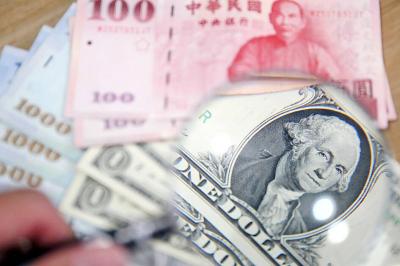Car shows, it has to be said, are for men. The talk is of torque and horsepower. The biggest names, Porsche and Ferrari, are testosterone on wheels, while the lesser ones adorn their cars with slinky women, lending these shows a retro feel that is part The Price Is Right, part Playboy Club.
So when Volvo rolled into the Geneva Motor Show this week with a car designed by women, for women, the reaction among the mostly male crowd can best be described as a collective grinding of the gears.
They gaped at the car's gull-wing doors, designed to make it easier for women to enter and exit. They clucked at the rear seats, which flip up like theater seats to store shopping bags. They lampooned a rubber bumper that swathes the car, protecting it from parking-lot dings and scratches.

PHOTO: EPA
"It's not even a theory, it's nonsense," said Michael Ganal, the head of sales and marketing for BMW.
Robert Lutz, the vice chairman of General Motors, said the whole idea was sexist.
"Most women would say: `I send my husband out to do the shopping. Let him have the car with the rubber bumpers,'" he said.
With this much vitriol, it is obvious that Volvo, the Swedish subsidiary of the Ford Motor Co, is tweaking the folkways of the industry. The question is whether Volvo's car will prove to be a gimmick or a pioneering response to the growing influence of female consumers in the auto market.
Volvo's designers concede that their car, known as the YCC, will not be built in anything close to its current form. But they said that many of its innovations are sure to turn up in other Volvo models. Given that 54 percent of its customers in the US are women, that could be shrewd marketing.
"Men and women really want the same things in cars," Camilla Palmertz, 36, the Volvo project manager, said. "But women want more. There's no car out there right now that fulfills all their criteria."
Over the last year, Volvo set loose a 120-person team to design a car that would meet what Palmertz said were the six main desires of female car buyers: ease of parking, comfortable seats, visibility, ample storage space, easy maintenance and the ability to personalize one's vehicle.
Not every member of the team was a woman, Palmertz said, but the core group of project leaders and designers was restricted to women. Aside from the go-ahead for the project, which was given by Volvo's chief executive, Hans-Olov Olsson, all major decisions were made by women.
The resulting vehicle looks nothing like the rounded minivans or hatchbacks that carmakers have historically aimed at women. With a sweeping roof and large alloy wheels, plus squat, sturdy dimensions, the YCC has a hybrid style that its designers liken to a rugged sports coupe.
"We're typical women," said Anna Rosen, who designed the exterior. "We want a mix of the best of everything."
Rosen, 28, said the car was aimed at independent women. While they could be mothers, the more likely owner is single. With computer-assisted parallel parking, the car is clearly designed for city streets.
For decades, carmakers have tried, however clumsily, to appeal to women. In the 1950s, Dodge introduced a pink car known as "La Femme," which had a compartment on the back of the seat that held cosmetics.
It was a fiasco, which Lutz said led Detroit to steer clear of cars that played to gender stereotypes.
In recent years, Ford, Nissan and Mazda have all used female designers to devise women-friendly touches for cars and vans. Even Porsche, the German sports car maker synonymous with manly motoring, sought to appeal to women with its new sport utility vehicle, the Cayenne.
But the industry has avoided labeling cars as women-friendly because it does not want to alienate half its market. For the same reason, companies try to avoid being tagged as catering to older customers.
"Volvos, because they are safe, did come to appeal to more mature drivers," said Garel Rhys, director of the automotive industry research group at Cardiff University in Wales. "I used to say laughingly that Volvo should put Braille on its steering wheel. They didn't like that image."
Like other carmakers, Volvo is predominantly male. But Sweden is an unusually egalitarian society, even by Western standards. Several executives said it was no surprise that this project happened there.
"This is not just a token gesture," said Mark Fields, the head of Ford's Premier Automotive Group, which includes Volvo, Jaguar, and Land Rover. "What we're really testing is a list of options."
Some of the car's features benefit men as much as women. A computer records the driver's body measurements so that each time he or she climbs into the car, the seat and steering wheel adjust. The gasoline tank has a roller-ball valve opening, like a race car, so one does not have to unscrew a cap.
Other devices seem more women-friendly. The seat covers can be easily removed, giving the owner the option of changing colors and patterns. The head-rests have a gap in the center to accommodate a ponytail.
The doors, which swing up and out at the touch of a button, are the car's most eye-catching detail. Volvo's designers say they would be a godsend to a woman laden with shopping bags. Other carmakers dared Volvo to try to open the doors in an average-size garage.
The wrap-around bumper drew similar catcalls. Rosen said the car could tolerate "creative driving" in parking lots and other tight spaces, without having to be returned to the shop for repairs. Lutz said this perpetuated the image that women are worse drivers than men.
Volvo's rivals do not dispute the growing influence of women. BMW estimates that in the US, 50 percent to 60 percent of the drivers of its X5 sport utility vehicle are female.
But Ganal said: "We never approach a car by asking, Is the car more used by males or females? We ask, What is the purpose of the car?"
Even Volvo's designers accepted one limitation. The Volvo emblem is its name stamped on the universal symbol of the male gender, a circle with an arrow pointing up and to the right. The designers said they toyed with the idea of changing the emblem to the universal symbol for woman.
Then, said Lena Ekelund, the project's deputy technical manager, "we decided we would just leave it alone."

The US dollar was trading at NT$29.7 at 10am today on the Taipei Foreign Exchange, as the New Taiwan dollar gained NT$1.364 from the previous close last week. The NT dollar continued to rise today, after surging 3.07 percent on Friday. After opening at NT$30.91, the NT dollar gained more than NT$1 in just 15 minutes, briefly passing the NT$30 mark. Before the US Department of the Treasury's semi-annual currency report came out, expectations that the NT dollar would keep rising were already building. The NT dollar on Friday closed at NT$31.064, up by NT$0.953 — a 3.07 percent single-day gain. Today,

‘SHORT TERM’: The local currency would likely remain strong in the near term, driven by anticipated US trade pressure, capital inflows and expectations of a US Fed rate cut The US dollar is expected to fall below NT$30 in the near term, as traders anticipate increased pressure from Washington for Taiwan to allow the New Taiwan dollar to appreciate, Cathay United Bank (國泰世華銀行) chief economist Lin Chi-chao (林啟超) said. Following a sharp drop in the greenback against the NT dollar on Friday, Lin told the Central News Agency that the local currency is likely to remain strong in the short term, driven in part by market psychology surrounding anticipated US policy pressure. On Friday, the US dollar fell NT$0.953, or 3.07 percent, closing at NT$31.064 — its lowest level since Jan.

The New Taiwan dollar and Taiwanese stocks surged on signs that trade tensions between the world’s top two economies might start easing and as US tech earnings boosted the outlook of the nation’s semiconductor exports. The NT dollar strengthened as much as 3.8 percent versus the US dollar to 30.815, the biggest intraday gain since January 2011, closing at NT$31.064. The benchmark TAIEX jumped 2.73 percent to outperform the region’s equity gauges. Outlook for global trade improved after China said it is assessing possible trade talks with the US, providing a boost for the nation’s currency and shares. As the NT dollar

The Financial Supervisory Commission (FSC) yesterday met with some of the nation’s largest insurance companies as a skyrocketing New Taiwan dollar piles pressure on their hundreds of billions of dollars in US bond investments. The commission has asked some life insurance firms, among the biggest Asian holders of US debt, to discuss how the rapidly strengthening NT dollar has impacted their operations, people familiar with the matter said. The meeting took place as the NT dollar jumped as much as 5 percent yesterday, its biggest intraday gain in more than three decades. The local currency surged as exporters rushed to